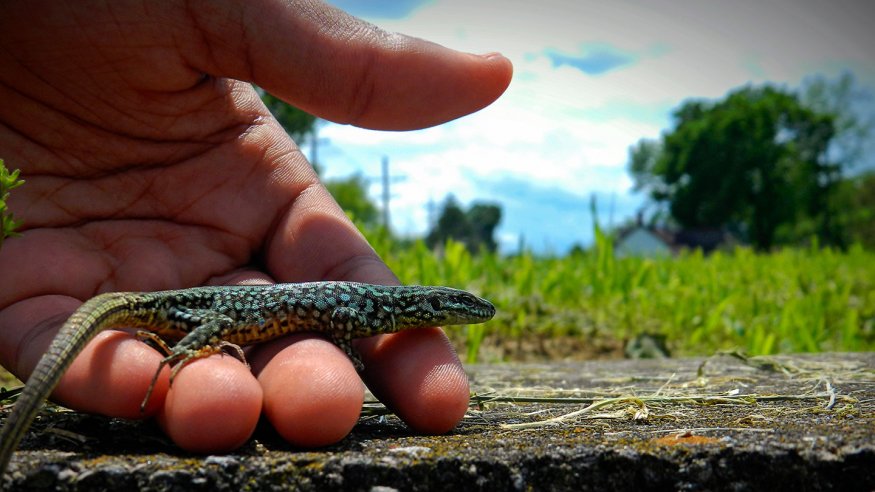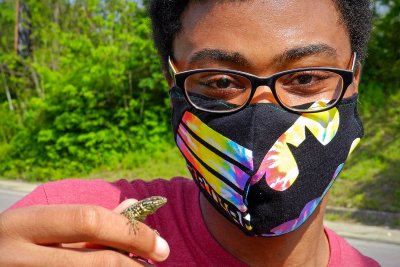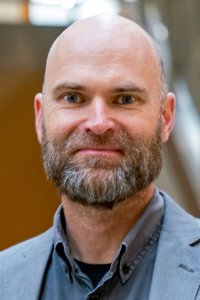
Agile Adaptation
Ohio Wesleyan Students, Professor Pivot When Pandemic Interrupts International Research Plans
Their plan was to travel to southern France to study how a local lizard is responding to climate change.
Though the pandemic prevented Ohio Wesleyan University’s Sierra Spears ’22, Princeton Vaughn ’22, and assistant professor of zoology Eric Gangloff from visiting the Pyrenees mountains this summer, the quick-thinking trio followed the lizard’s example – and adapted.
In the months since their trip was canceled, the OWU scientists have successfully completed multiple related research projects that could be conducted without international travel, presented their findings at the 2021 Society for Integrative and Comparative Biology meeting, and begun drafting two papers to submit to scientific journals.
“Both Princeton and Sierra have been enormously resilient and flexible this past year, qualities that will undoubtedly serve them well in their future careers,” Gangloff, Ph.D., said of his students. “They have both demonstrated great curiosity in exploring these ideas and creativity in how we can conduct these experiments.
“I have learned a great deal from working with both of them, and I consider both of these projects to be true collaborations,” Gangloff said. “I am lucky to be working with such talented researchers.”
‘Addressing Fundamental Questions’

For Sierra Spears, a pre-professional zoology major and chemistry minor from Bowling Green, Ohio, the research pivot meant analyzing data shared by collaborators in France rather than collecting the information first-hand. In addition to Gangloff, Spears also worked with OWU student Ciara Pettit ’23 of South Euclid, Ohio, on the project.
Spears’ presentation for the Society for Integrative and Comparative Biology is titled “Plasticity in Thermoregulatory Behavior and Performance in Response to Hyperoxia in a High-Elevation Specialist Lizard, Iberolacerta bonnali.”
The lizards involved “are classified as near-threatened,” she said, “because, unlike lowland species that can move to properly thermoregulate, high-elevation lizards have nowhere to go as climate warms.”
“Sierra's work is directly related to climate change,” Gangloff added. Under climate change scenarios, we don’t know if the lizards will have anywhere to go if their habitat becomes unsuitable.
“There is a chance they could move down in elevation if they can deal with the warmer temperatures, but her project shows that they do not do well when transported to lower elevation, at least in the short term,” Gangloff said. “So her work is addressing fundamental questions about how physiology can respond to novel conditions, but also questions about conservation for a species of concern.”
Spears said future research in the area will “look deeper into possible physiological explanations like red blood cell count, reactive oxygen species, or hemoglobin concentrations.”
Spears and Gangloff are in the near-final stages of analyzing data and preparing an article they have been invited to submit to a special issue of the journal Diversity on the evolutionary ecology of lizards.
‘Highly Altered Habitats’

For Princeton Vaughn, a zoology major from Bowie, Maryland, the pandemic pivot meant traveling to Cincinnati, Ohio, in collaboration with Gangloff and OWU student Wyatt McQueen ’22 of Heath, Ohio.
Vaughn’s presentation for the Society for Integrative and Comparative Biology is titled “Location, Location, Location: Testing the Performance Implications of Morphological Shifts in Introduced Urban Lizards.”
The Ohio Wesleyan researchers chose Cincinnati, Vaughn said, because a child smuggled 10 common wall lizards from their home in Italy to Ohio in the 1950s.
“Today, their population has exploded into hundreds of thousands,” he said. Using both museum specimens and live reptiles, “the goal is to see if and how the invasive (lizard) population has evolved over its time in the novel habitat of Cincinnati and if those changes might be related to sprint performance.”
“Princeton’s project is important,” Gangloff said, “because it allows us to understand how organisms may respond to highly altered habitats … how living in this new, urban environment may have led to adaptive shifts in their body shape (leg length, body width, etc.), especially in relation to their ability to run under different conditions. So his work is exploring fundamental issues relating form-to-function in vertebrates but also exploring how organisms may cope with highly anthropogenic landscapes, like a city.”
Vaughn said he expects future research to explore “how both clinging ability and climbing performance interact with morphology.”
For now, he is continuing to analyze data and draft (as lead author) an article that he and Gangloff hope to submit this semester to the Biological Journal of the Linnean Society. In addition, Vaughn is working with OWU faculty member Laura Tuhela-Reuning, Ph.D., to use the university’s scanning transmission electron microscope to examine lizard claws and their climbing/grasping ability.
Elevated Research

Gangloff’s own Society for Integrative and Comparative Biology presentation is titled “Adaptation and Plasticity in the Multivariate Thermal Phenotype of Common Wall Lizards.”
“This is a widespread species found across much of southern Europe, generally at low elevations,” said Gangloff, who joined the Ohio Wesleyan faculty in 2019. “However, in recent years as temperatures have warmed, this species has been observed moving up in elevation to track these preferred thermal environments.”
As they move higher, he said, the lizards face issues such as less oxygen, and his collaborative project explores how the reptiles respond to the change in elevation. The goal is to determine what environments, currently not inhabited by the lizards, may be suitable for them during continued climate change.
Gangloff collected his data while working as a post-doctoral researcher with the Station d’Ecologie Théorique et Expérimentale du CNRS in Moulis, France. He worked in collaboration with Brooke Bodensteiner and Martha Muñoz, both of Yale University, and with Fabien Aubret and Laura Kouyoumdjian, both of CNRS.
Passports Ready
Gangloff said he is hopeful that he and a group of Ohio Wesleyan students will be able to travel to France this summer to continue researching lizards and their adaptations to climate change.
But if the determined scientists face more travel delays, expect more agile adaptation.
“We may complete a project here in Ohio instead,” Gangloff said.
In addition to presenting their work at the 2021 Society for Integrative and Comparative Biology meeting, Spears and Vaughn also presented earlier versions of their findings at Ohio Wesleyan’s Summer Science Research Symposium in September.
Learn more about Ohio Wesleyan’s zoology department at owu.edu/zoology and more about the University’s annual Summer Science Research Program and Symposium at owu.edu/ssrp.
